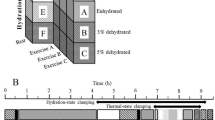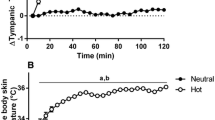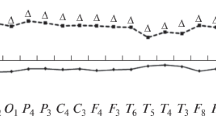Abstract
Purpose
Whole-body thermal and hydration clamps were used to evaluate their independent and combined impact on the electrical activity of the brain. It was hypothesised that those stresses would independently modify the electroencephalographic (EEG) responses, with those changes being greater when both stresses were superimposed.
Methods
Alpha and beta spectral data (eyes closed) were collected from the frontal, central-parietal and occipital cortices of both hemispheres in resting, healthy and habitually active males (N = 8; mean age 25 years). Three dehydration states were investigated (euhydrated and 3% and 5% mass decrements) in each of two thermal states (normothermia [mean body temperature 36.3 °C] and moderate hyperthermia [38.4 °C]). The combination of those passively induced states yielded six levels of physiological strain, with the EEG data from each level separately examined using repeated-measures ANOVA with planned contrasts.
Results
When averaged across the frontal cortices, alpha power was elevated relative to the occipital cortices during moderate hyperthermia (P = 0.049). Conversely, beta power was generally reduced during hyperthermia (P = 0.013). Neither the alpha nor beta power spectra responded to dehydration, nor did dehydration elevate the heat-induced responses (P > 0.05).
Conclusion
Moderate hyperthermia, but neither mild nor moderate dehydration, appeared to independently alter brain electrical activity. Moreover, the combination of moderate hyperthermia with 5% dehydration did not further increase those changes. That outcome was interpreted to mean that, when those states were superimposed, the resulting neurophysiological changes could almost exclusively be attributed to the thermal impact per se, rather than to their combined influences.



Similar content being viewed by others
Abbreviations
- EEG:
-
Electroencephalographic
- EOG:
-
Electro-oculographic
- E1, E3, E5 and E6:
-
Electrode positions above and below the left eye, and at the outer canthi of the left and right eyes (respectively)
References
Åkersted T, Gillberg M (1990) Subjective and objective sleepiness in the active individual. Int J Neurosci 52:29–37
Baker LB, Lang JA, Kenney WL (2009) Change in body mass accurately and reliably predicts change in body water after endurance exercise. Eur J Appl Physiol 105:959–967
Barnett A, Maughan RJ (1993) Response of unacclimatized males to repeated weekly bouts of exercise in the heat. Br J Sports Med 27:39–44
Barry RJ, Clarke AR, Johnstone SJ, Magee CA, Rushby JA (2007) EEG differences between eyes-closed and eyes-open resting conditions. Clin Neurophysiol 118:2765–2773
Barry RJ, Rushby JA, Wallace MJ, Clarke AR, Johnstone SJ, Zlojutro I (2005) Caffeine effects on resting-state arousal. Clin Neurophysiol 116:2693–2700
Becerra LR, Breiter HC, Stojanovic M, Fishman S, Edwards A, Comite AR, Gonzalez RG, Borsook D (1999) Human brain activation under controlled thermal stimulation and habituation to noxious heat: an fMRI study. Magn Reson Med 41:1044–1057
Bond A, Lader M (1974) The use of analogue scales in rating subjective ratings. Br J Med Psychol 47:211–218
Brümmer V, Schneider S, Abel T, Vogt T, Strüder HK (2011) Brain cortical activity is influenced by exercise mode and intensity. Med Sci Sports Exerc 43:1863–1872
Cheuvront SN, Carter R, Montain SJ, Sawka MN (2004) Daily body mass variability and stability in active men undergoing exercise-heat stress. Int J Sport Nutr Exerc Metab 14:532–540
Cheuvront SN, Montain SJ (2017) Myths and methodologies: making sense of exercise mass and water balance. Exp Physiol 102:1047–1053
Cooper KE, Cranston WI, Snell ES (1964) Temperature in the external auditory meatus as an index of central temperature changes. J Appl Physiol 19:1032–1035
Cooper NR, Burgess AP, Croft RJ, Gruzelier JH (2006) Investigating evoked and induced electroencephalogram activity in task-related alpha power increases during an internally directed attention task. Neuro Rep 17:205–208
Cotter JD, Patterson MJ, Taylor NAS (1995) A method for clamping human skin and body core temperatures. Proc Aust Physiol Pharmacol Soc 26:204P
Crabbe JB, Dishman RK (2004) Brain electrocortical activity during and after exercise: a quantitative synthesis. Psychophysiology 41:563–574
Croft RJ, Barry RJ (2000) EOG correction of blinks with saccade coefficients: a test and revision of the aligned-artefact average solution. Clin Neurophysiol 111:444–451
Curcio G, Ferrara M, Moroni F, D’Inzeo G, Bertini M, De Gennaro L (2005) Is the brain influenced by a phone call? An EEG study of resting wakefulness. Neurosci Res 53:265–270
Deboer T (1998) Brain temperature dependent changes in the electroencephalogram power spectrum of humans and animals. J Sleep Res 7:254–262
DuBois EF (1941) The temperature of the human body in health and disease. In: American Institute of Physics. Temperature: its measurement and control in science and industry. Reinhold Publishing Corporation, New York, pp 24–40.
Dubois M, Coppola R, Buchsbaum MS, Lees DE (1981) Somatosensory evoked potentials during whole body hyperthermia in humans. Electroencephalogr Clin Neurophysiol 52:157–162
Dubois M, Sato S, Lees DE, Bull JM, Smith R, White BG, Moore H, Macnamara TE (1980) Electroencephalographic changes during whole body hyperthermia in humans. Electroencephalogr Clin Neurophysiol 50:486–495
Duning T, Kloska S, Steinsträter O, Kugel H, Heindel W, Knecht S (2005) Dehydration confounds the assessment of brain atrophy. Neurology 64:548–550
Engell DB, Maller O, Sawka MN, Francesconi RN, Drolet L, Young AJ (1987) Thirst and fluid intake following graded hypohydration levels in humans. Physiol Behav 40:229–236
Farrell MJ (2016) Regional brain responses in humans during body heating and cooling. Temperature 3:220–231
Ftaiti F, Kacem A, Jaidane N, Tabka Z, Dogui M (2010) Changes in EEG activity before and after exhaustive exercise in sedentary women in neutral and hot environments. Appl Ergon 41:806–811
Gagge AP, Stolwijk JAJ, Hardy JD (1967) Comfort and thermal sensations and associated physiological responses at various ambient temperatures. Environ Res 1:1–20
Hales JRS, Rowell LB, King RB (1979) Regional distribution of blood flow in awake heat-stressed baboons. Am J Physiol 273:H705–H712
Hardy JD, DuBois EF (1938) Basal metabolism, radiation, convection, and vaporization at temperatures of 22 to 35 °C. J Nutr 15:477–497
Hayward JS, Eckerson JD, Kemna D (1984) Thermal and cardiovascular changes during three methods of resuscitation from mild hypothermia. Resuscitation 11:21–33
Jasper HH (1958) The ten-twenty electrode system of the International Federation. Electroencephalogr Clin Neurophysiol 10:371–375
Kalevo L, Miettinen T, Leino A, Kainulainen S, Korkalainen H, Myllymaa K, Töyräs J, Leppänen T, Laitinen T, Myllymaa S (2020) Effect of sweating on electrode-skin contact impedances and artifacts in EEG recordings with various screen-printed Ag/Agcl electrodes. IEEE Access 8:50934–50943
Kempton MJ, Ettinger U, Schmechtig A, Winter EM, Smith L, McMorris T, Wilkinson ID, Williams SCR, Smith MS (2009) Effects of acute dehydration on brain morphology in healthy humans. Hum Brain Mapp 30:291–298
Kempton MJ, Ettinger U, Foster R, Williams SCR, Calvert GA, Hampshire A, Zelaya FO, O’Gorman RL, McMorris T, Owen AM, Smith MS (2011) Dehydration affects brain structure and function in healthy adolescents. Hum Brain Mapp 32:71–79
Kiyatkin EA (2005) Brain hyperthermia as physiological and pathological phenomena. Brain Res Rev 50:27–56
Lee JY, Wakabayashi H, Wijayanto T, Tochihara Y (2010) Differences in rectal temperatures measured at depths of 4–19 cm from the anal sphincter during exercise and rest. Eur J Appl Physiol 109:73–80
Matthews WB, Read DJ, Pountney E (1979) Effect of raising body temperature on visual and somatosensory evoked potentials in patients with multiple sclerosis. J Neurol Neurosurg Psychiatry 42:250–255
Maughan RJ, Shirreffs SM, Watson P (2007) Exercise, heat, hydration and the brain. J Am Coll Nutr 26:604S–612S
Maw GJ, Mackenzie IL, Taylor NAS (2000) Can skin temperature manipulation, with minimal core temperature change, influence plasma volume in resting humans? Eur J Appl Physiol 81:159–162
Mekjavić IB, Remple ME (1990) Determination of oesophageal probe insertion length based on standing and sitting height. J Appl Physiol 69:376–379
Merson SJ, Maughan RJ, Shirreffs SM (2008) Rehydration with drinks differing in sodium concentration and recovery from moderate exercise-induced hypohydration in man. Eur J Appl Physiol 103:585–594
Montain SJ, Cheuvront SN (2008) Fluid, electrolyte and carbohydrate requirements for exercise. In: Taylor NAS, Groeller H (eds) Physiological bases of human performance during work and exercise. Churchill Livingstone, Philadelphia, pp 563–573
Moreas H, Deslandes A, Silveira H, Ribeiro P, Cagy M, Piedade R, Pompeu F, Laks J (2011) The effect of acute effort on EEG in healthy young and elderly subjects. Eur J Appl Physiol 111:67–75
Nakata H, Oshiro M, Namba M, Shibasaki M (2015) Effects of passive heat stress on human somatosensory processing. Am J Physiol 309:R1387–R1396
Nielsen B, Hyldig T, Bidstrup F, González-Alonso J, Christoffersen GRJ (2001) Brain activity and fatigue during prolonged exercise in the heat. Plügers Arch 442:41–48
Nunneley SA, Martin CC, Slauson JW, Hearon CM, Nickerson LDH, Mason PA (2002) Changes in regional cerebral metabolism during systemic hyperthermia in humans. J Appl Physiol 92:846–851
Nybo L, Nielsen B (2001) Perceived exertion is associated with an altered brain activity during exercise with progressive hyperthermia. J Appl Physiol 91:2017–2023
Patterson MJ, Stocks JM, Taylor NAS (2014) Whole-body fluid distribution in humans during dehydration and recovery, before and after humid-heat acclimation induced using controlled hyperthermia. Acta Physiol 210:899–912
Sawka MN, Cheuvront SN, Kenefick RW (2015) Hypohydration and human performance: impact of environment and physiological mechanisms. Sports Medicine 45:S51–S60
Segrave RA, Thomson RH, Cooper NR, Croft RJ, Sheppard DM, Fitzgerald PB (2012) Emotive interference during cognitive processing in major depression: and investigation of lower alpha 1 activity. J Affect Disord 141:185–193
Stocks JM, Patterson MJ, Hyde DE, Jenkins AB, Mittleman KD, Taylor NAS (2004) Effects of immersion water temperature on whole-body fluid distribution in humans. Acta Physiol Scand 182:3–10
Szinnai G, Schachinger H, Arnaud MJ, Linder L, Keller U (2005) Effect of water deprivation on cognitive-motor performance in healthy men and women. Am J Physiol 289:R275–R280
Taylor NAS, Tipton MJ, Kenny GP (2014) Considerations for the measurement of core, skin and mean body temperatures. J Therm Biol 46:72–101
Todd G, Gordon CJ, Groeller H, Taylor NAS (2014) Does intramuscular thermal feedback modulate eccrine sweating in exercising humans? Acta Physiol 212:86–96
Trangmar SJ, Chiesa ST, Llodio I, Garcia B, Kalsi KK, Secher NH, González-Alonso J (2015) Dehydration accelerates reductions in cerebral blood flow during prolonged exercise in the heat without compromising brain metabolism. Am J Physiol 309:H1598–H1607
Vallerand AL, Savourey G, Hanniquet A, Bittel JHM (1992) How should body heat storage be determined in humans: by thermometry or calorimetry? Eur J Appl Physiol 65:286–294
van den Heuvel AMJ, Haberley BJ, Hoyle DJR, Taylor NAS, Croft RJ (2017) The independent influences of heat strain and dehydration upon cognition. Eur J Appl Physiol 117:1025–1037
van den Heuvel AMJ, Haberley BJ, Hoyle DJR, Croft RJ, Peoples GE, Taylor NAS (2020) Hyperthermia and dehydration: their independent and combined influences on physiological function during rest and exercise. Eur J Appl Physiol. https://doi.org/10.1007/s00421-020-04493-4
Watson P, Head K, Pitiot A, Morris P, Maughan RJ (2010) Effects of exercise and heat-induced hypohydration on brain volume. Med Sci Sports Exerc 42:2197–2204
Wilson MM, Morley JE (2003) Impaired cognitive function and mental performance in mild dehydration. Eur J Clin Nutr 57:S24–S29
Wittbrodt MT, Sawka MN, Mizelle JC, Wheaton LA, Millard-Stafford ML (2018) Exercise-heat stress with and without water replacement alters brain structures and impairs visuomotor performance. Physiol Rep 6:e13805
Acknowledgements
AMJvdH held an Australian Post-Graduate Award from the University of Wollongong (Australia) throughout this investigation. NAST was supported during the writing of this manuscript by the Brain Pool Program through the National Research Foundation of Korea (NRF), funded by the Ministry of Science and Information, Communication and Technology (Grant number: 2019H1D3A2A01061171). No other funding was provided by agencies in the public, commercial or not-for-profit sectors.
Author information
Authors and Affiliations
Contributions
AMJvdH, NAST and RJC designed and planned this research, and were involved in data analysis and all phases of manuscript preparation. AMJvdH ran the experiments, and was also responsible for data collection. BJH and DJRH were essential participants in subject preparation, data collection, laboratory operations and manuscript preparation. NAST supervised the thermal physiological aspects of this project, whilst RJC was responsible for the neurophysiological methods. All authors read and approved the final version of the manuscript and its submission for publication, and agree to be accountable for this work, ensuring that questions related to the accuracy or integrity of any part of the work are appropriately investigated and resolved. All persons designated as authors qualify for authorship, and all those who qualify for authorship have been listed as authors.
Corresponding author
Ethics declarations
Conflict of interest
There are no conflicts of interest to declare.
Additional information
Communicated by George Havenith.
Publisher's Note
Springer Nature remains neutral with regard to jurisdictional claims in published maps and institutional affiliations.
Rights and permissions
About this article
Cite this article
van den Heuvel, A.M.J., Haberley, B.J., Hoyle, D.J.R. et al. Hyperthermia, but not dehydration, alters the electrical activity of the brain. Eur J Appl Physiol 120, 2797–2811 (2020). https://doi.org/10.1007/s00421-020-04492-5
Received:
Accepted:
Published:
Issue Date:
DOI: https://doi.org/10.1007/s00421-020-04492-5




